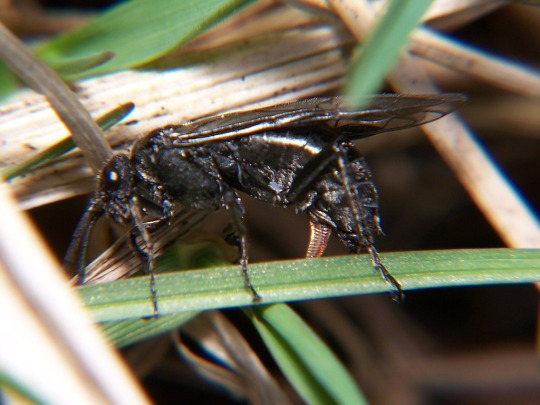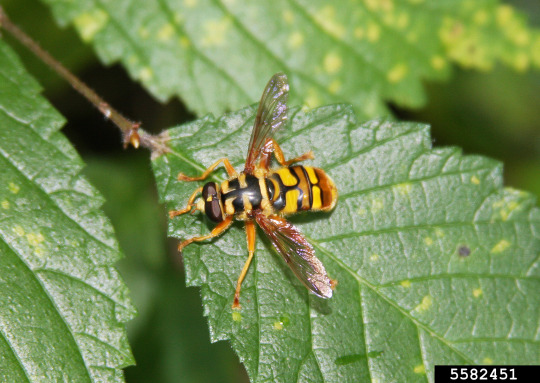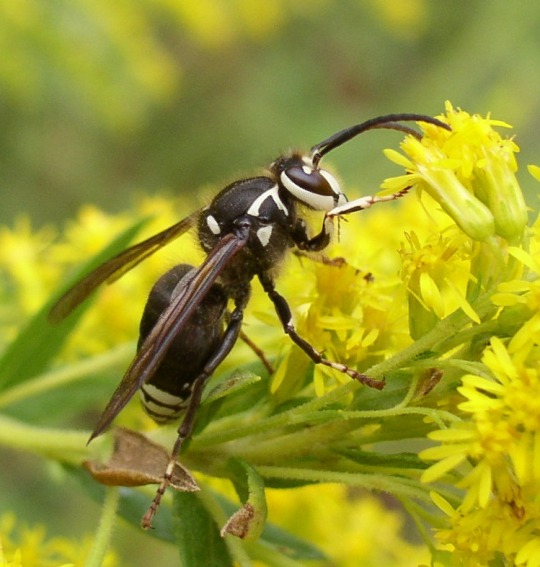#SORRY. YOU HAVE ACTIVATED HYMENOPTERA SPECIAL INTEREST MODE.
Explore tagged Tumblr posts
Note
terribly sorry if this is a weird question but i would LOVE to hear more about wasps . funky little dudes

wasps are a relatively new species in terms of insect evolution, having appeared in the jurassic period alongside the first dinosaurs. there are hundreds of thousands of species, which could include ants and bees depending on your exact definition. they're all included in the group apocrita, or the "wasp waisted" hymenoptera. they are some of the most successful insects on the planet.
DID YOU KNOW?: the stinger of apocrita is a highly adapted ovipositor, the organ used for egg laying.
STEP ONE: their ancestors, the sawflies, had evolved a serrated ovipositor that could bore into plant material as a safe place to lay their eggs.


STEP TWO: the first wasps would use the ovipositor to instead lay their eggs inside of other animals (parasitoidism), which then provides the developing young plenty of food. many of these wasps would develop a unique variety of venoms to aid in the capture of prey, often by paralysis.
DID YOU KNOW?: there are more parasitoid wasps than any other kind of wasp, with an estimated 100,000 species! this includes the iconic cicada killer wasp.
STEP THREE: the transition from egg laying to defense is not entirely understood, but is believed by some to have been a direct response to predation by vertebrates. if you think about it, it's not all that easy to sting through a tough exoskeleton (though it can be done), it's much easier to sting soft, fleshy things that are trying to eat your delicious grub children. these wasps no longer lay eggs with the ovipositor, instead having an opening at the base of the stinger. the venom would be adapted to illicit a pain response, a harsh lesson to not mess with wasps!
DID YOU KNOW?: male wasps CANNOT sting as they do not have an ovipositor. though, some males will still mimic stinging, or even have pointed abdomens to help sell the illusion.
QUICKFIRE ROUND:
while wasps are famously eusocial and will often live in large communal hives, the vast majority of wasps are solitary and live on their own.
the largest species of wasp is the northern giant hornet, who's queens are around 2 inches in length. the smallest species of wasp is also the smallest insect ever! dicopomorpha echmepterygis males have been measured as small as 139 micrometres in length.
its common knowledge that wasps can sting multiple times and honey bees cant. this is a unique adaptation of the honey bee, who deliver a more potent sting by leaving the stinger embedded in the victim as it continues to pump rounds and rounds of venom. unfortunately, the stinger is directly attached to many vital organs, which are then damaged in the process, causing the honey bee to die.
insects breathe by absorbing oxygen directly into their "blood". wasps aid in this by rapidly expanding and collapsing their abdomen to force air in and out. if her butt is vibrating, shes just taking a breath :)

the iconic coloration of the wasp, usually yellow and black, is part of their defensive strategy! this is a form of aposematism, the advertising of danger to potential predators. they want you to notice them, so you know to steer clear!
the coloration is SO iconic that thousands of insect species mimic it in hopes of also warding off predators. this includes flies, moths and butterflies, and even their own ancestors, the sawflies.


parasitoid wasps are very specific in their choice of prey, likely due to the unique cocktail of venom they must possess to influence any given species. for any arthropod, there is a species of wasp that specializes in parasitizing THAT specific arthropod.
because i know some people are wondering, the venom of parasitoid wasps can only effect arthropods, there will be no wasp based mind control within the next few million years. some parasitoids have been known to sting defensively, which is still quite painful depending on the exact species.
some wasps are HYPERPARASITOIDS, meaning they will lay their eggs on other parasitoids that are already parasitizing something. its parasitoids all the way down.
one of these hyperparasitoids is the velvet ant. despite it's common name, they're actually a species of wasp with flightless females. the males do possess wings, and in some species, will assist the female by carrying her to an environment with better resources.
the venom of gall wasps will, when inserted into a tree or other vegetation, cause it to grow a mass, known as a gall. basically a bootleg fruit, filled with nutrients. these wasp galls will then safely house the wasp's young which eat it from the inside out, before emerging as adult wasps.
obviously, theres wasps that parasitize the gall wasps inside the gall.
fig wasps are the only animals that can pollinate figs, and do so by crawling inside to lay their eggs before dying inside the fruit. well, the only animal other than humans, which find figs quite tasty but don't typically enjoy eating dead wasps.
i probably wont ever get a better opportunity to share this information, sorry: the queen honey bee mating with a drone is audible to the human ear, making a popping sound. the drone's endophallus (penis) is violently detached in the process and he dies soon after.
lastly, lets just marvel at the beauty of the wasp. they have some of the most striking appearances of any animals on earth.






i am just fillled with awe when i look at them. a powerful and intimidating predator that takes great care in raising the next generation. perhaps my favorite animal.
#SORRY. YOU HAVE ACTIVATED HYMENOPTERA SPECIAL INTEREST MODE.#corrections: i say 'species' when i mean 'group' a lot. also i mixed up jurassic and triassic dinosaurs had already been around for awhile
164 notes
·
View notes